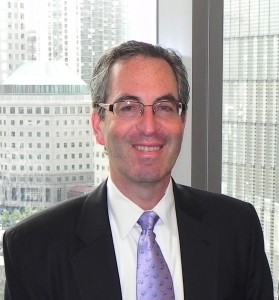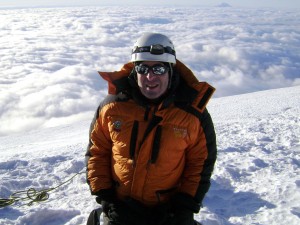The New Yorker
Big Apple native Larry Landau’s road to Wall Street ran through Seattle
 Larry Landau (MBA 1982) knows most every gargoyle in lower Manhattan.
Larry Landau (MBA 1982) knows most every gargoyle in lower Manhattan.
In more than 30 years working in and around Wall Street, he’s developed a curator’s knowledge of the area art and architecture.
This is, perhaps, inspired by the memory of where his career began, on the 101st floor of One World Trade Center long before it was destroyed on 9/11. Or by his years working in the historic Woolworth Building. Or by the view, from his current office at Moody’s Corporation, to the renaissance of Ground Zero, and the rise of the Freedom Tower.
Landau is indigenous to the city’s financial district. But he’s a master of information technology, not finance.
To get to Wall Street, this native New Yorker went through Seattle.
“Computers”
As a teen, it became clear to Landau that he did not intend to make a career of his father’s corrugated box business. One day the elder Landau suggested an alternative career in a scene straight out of “The Graduate.”
“He pulled me aside,” recalls Landau. “But instead of whispering ‘plastics,’ it was ‘computers.’ And he was right.”
Landau studied computer science at Rutgers. “But I didn’t consider myself God’s gift to software programming,” he laughs. “So I needed to find a different career within IT.”
He decided to get an MBA to sort things out. Having fallen for the Northwest during an exchange year at the University of Oregon, he chose to continue studies at the Foster School.
 Landau bought a bike and a Gore-Tex jacket to commute to campus. He became a regular at Starbucks (store #2). He gazed regularly at Mount Rainier dreaming of scaling it someday (finally accomplished after an MBA reunion 25 years later). “I fell into the spirit of the Pacific Northwest pretty quickly,” he says.
Landau bought a bike and a Gore-Tex jacket to commute to campus. He became a regular at Starbucks (store #2). He gazed regularly at Mount Rainier dreaming of scaling it someday (finally accomplished after an MBA reunion 25 years later). “I fell into the spirit of the Pacific Northwest pretty quickly,” he says.
At Foster he stitched together a curriculum in operations research and management science to create an information management focus that didn’t yet exist. His master’s thesis proposed that humans can make better decisions with computer-based data.
Upon graduation, he set off to prove it.
Eastward ho!
Though he had developed a great affinity for Seattle, opportunity in those days beckoned back east. Landau initially found work with Deloitte Consulting, and served a variety of financial services clients. The intersection of finance, technology and information became his specialty.
And though he detoured into marketing, business development and mergers & acquisitions work, he always gravitated back to information management.
He has served a tour of blue-chip companies: Deloitte, Dow Jones, PaineWebber, GE, Thomson Reuters, and now Moody’s. As managing director of infrastructure, Landau is responsible for running the global IT infrastructure and managing end-to-end delivery of IT strategy for the influential credit rating agency.
Inflection points
Mastering the constantly advancing landscape of information technologies has been no mean feat. Landau’s career has spanned the seismic disruptions of the personal computer, the digital local network, the Internet, and now cloud computing.
Whatever the job description, continuous learner has always been a requirement.
“Once you learn how to learn in a certain discipline,” he says, “you become hard-wired to that way of thinking.”
It’s served him well as he has managed information technologies in many firms that sell nothing but information. “That’s where those inflection technologies are key,” he says. “Newton once said that he was able to stand on the shoulders of giants that came before him to see just that much further. And so are we as we leverage these inventions for business.”
Reflection points
At Moody’s, Landau’s career has come full circle. He has successfully blended the traditions of Seattle technology and New York finance.
But as he peers from his office in 7 World Trade Center down to the 9/11 Memorial—its eternal waterfalls flowing into twin reflective pools that mark the footprint of the fallen towers, framed by a grove of young white oaks—he’s a New Yorker, through and through.
“I find it very inspirational watching the new buildings come up and the rebirth of the area,” he says. “It’s really quite remarkable.
